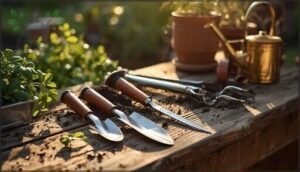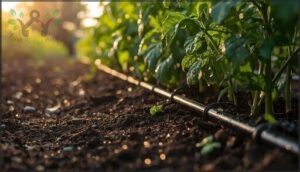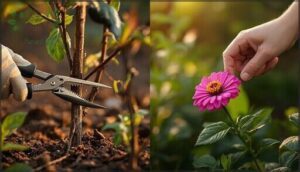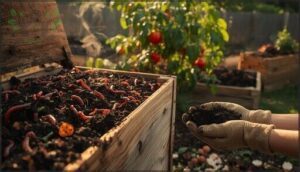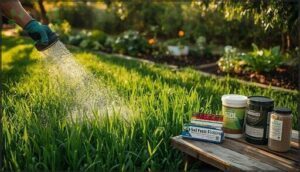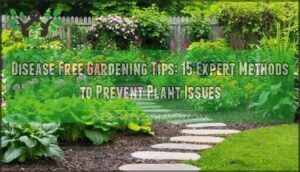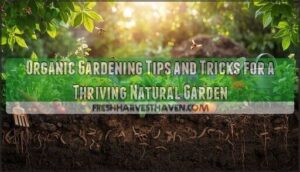This site is supported by our readers. We may earn a commission, at no cost to you, if you purchase through links.
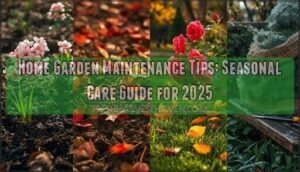
The difference between a struggling landscape and a flourishing one often comes down to knowing which tasks matter most and when to tackle them. Whether you’re protecting your pets from toxic plants, sharpening tools before they fail mid-project, or timing your pruning to boost blooms, strategic home garden maintenance tips keep problems small and manageable instead of overwhelming.
Table Of Contents
Key Takeaways
- Most garden failures stem from skipped maintenance routines rather than weather or soil issues, with success hinging on consistent seasonal care—from spring soil prep through winter protection—rather than luck or sporadic effort.
- Safety fundamentals like verifying pet-safe plant selections (avoiding 700+ toxic species), calling 811 before digging to prevent utility strikes, and maintaining sharp tools can prevent the 400,000 annual garden-related injuries while protecting both people and animals.
- Strategic seasonal tasks deliver outsized returns: applying 2-4 inches of mulch cuts water needs by 30% and suppresses 90% of weeds, while proper fall composting and spring soil testing eliminate unnecessary fertilizer costs and boost plant health for multiple growing cycles.
- Eco-friendly pest management through correct identification, beneficial insect habitats, and cultural practices like crop rotation (which cuts soil-borne disease by 90%) proves more effective than chemical interventions while building long-term garden resilience.
Essential Garden Safety and Preparation
Before you dig into your garden this season, taking a few safety precautions can save you from injuries, costly mistakes, and heartbreak over a sick pet. A little preparation goes a long way—from checking which plants might harm your furry friends to making sure you don’t accidentally slice through a gas line.
Let’s walk through the essential safety steps that’ll keep both you and your garden thriving.
Reviewing Garden Safety Guidelines
Before you turn the first spadeful of soil, pause and conduct a thorough garden risk assessment. Each year, around 400,000 Americans receive emergency treatment for lawn and garden tool injuries—a sobering reminder that safety first isn’t just a catchphrase.
Each year 400,000 Americans land in the ER from garden tool injuries—pause and assess risks before you dig
You’ll need proper safety gear, clear hazard awareness, and smart tool storage habits. Plan your emergency response, stay alert during pest control and disease management tasks, and you’ll cultivate confidence alongside your crops.
To minimize injuries, it’s vital to practice safe gardening techniques when working in your garden.
Pet-safe Plant Selection and Toxic Plant Awareness
Your garden risk assessment isn’t complete until you verify plant toxicity levels. The ASPCA lists over 700 toxic plant species that threaten pets—lilies alone trigger kidney failure in cats. Choose pet-safe alternatives like spider plants, marigolds, or basil to build pet friendly gardens.
Follow these garden safety tips: audit your beds annually, swap hazardous specimens for non toxic alternatives, and keep emergency veterinary contacts accessible. For a safer garden, research the toxic plant garden to identify harmful species.
Marking Underground Utilities Before Digging
Before you dig deeper than six inches, call 811 at least 48 hours ahead to request utility line marking—it’s mandated by law and prevents 76% of avoidable strikes.
Each year, 400,000 to 800,000 underground utility damages occur nationwide, with excavation safety breaches averaging $4,000 per incident.
Proper damage prevention through underground mapping protects your yard maintenance efforts and ensures safe gardening techniques.
Cleaning, Sharpening, and Maintaining Garden Tools
Once your lines are safely marked, turn your attention to tool sanitation and blade sharpening. Expert guidelines show cleaning after each use reduces disease spread by 60%.
Sharpen pruners every 4-6 weeks during peak season for 40% better efficiency, apply oil for rust prevention, and store equipment in dry spaces to extend lifespan fourfold while maintaining garden safety and precautions year-round.
Proper Lifting Techniques and Personal Protection
Protect your back while doing yard work—90% of lifting injuries happen with light objects when you use poor body mechanics. Follow these lifting techniques and gardening safety and precautions:
- Keep loads close to your torso and bend at your knees for back injury prevention
- Use ergonomic tools with long grips to minimize bending during garden care
- Wear sturdy gloves, long sleeves, and closed shoes as personal protective gear
- Take multiple trips with lighter loads instead of one heavy haul
- Stretch gently before lifting to prepare muscles for gardening basics
These body mechanics training principles reduce injury risk by over 50% while you master essential gardening tips.
Choosing and Caring for Garden Tools
You can’t maintain a garden well without the right tools in your hands. Quality equipment makes every task easier and safer, whether you’re pruning shrubs or turning compost.
Let’s look at how to choose tools that’ll last, keep them in top shape, and store them properly through the seasons.
Selecting Quality Tools for Different Tasks
Your choice in garden tools makes the difference between frustration and efficiency. Look for pruners with hardened steel blades and ergonomic grips for task specificity—they’ll handle everything from delicate roses to thick stems.
For digging work, spades with tempered boron steel resist soil corrosion better than aluminum alternatives.
Sustainable tools using bamboo or recycled materials support gardening basics while minimizing environmental impact. Quality equipment maintenance starts with smart selection.
Tool Maintenance for Longevity and Safety
Keep your tools sharp and clean after every use—dull blades slip 35% more often and make garden safety a real concern. Tool sharpening with diamond files and rust prevention through oil coatings extend equipment lifespan dramatically.
Essential tool care practices:
- Clean soil off metal surfaces immediately
- Apply boiled linseed oil to wooden grips annually
- Sharpen cutting edges twice per season
- Remove sap with alcohol or mineral spirits
- Inspect for cracks before each gardening session
Seasonal Tool Storage and Care Tips
Store your tools in a dry location to slash rust by 85%—moisture control makes all the difference in equipment maintenance. Wipe blades dry after each use, then apply oil before winterization to prevent corrosion.
Vertical storage solutions like pegboards boost space efficiency by 40% while keeping tools organized.
This garden maintenance routine extends tool lifespan by three to five years, proving proper storage solutions beat constant replacement.
Seasonal Garden Maintenance Tips
Your garden’s needs shift throughout the year, and staying ahead of those changes makes all the difference. Each season brings specific tasks that keep your plants healthy and your landscape thriving.
Here’s what you should focus on during spring, summer, fall, and winter to maintain a beautiful garden year-round.
Spring: Preparing Soil and Planting
Spring arrives as your garden’s clean slate, and success starts below ground. Test your soil quality early—most home soils show measurable nitrogen that can save you money on spring fertilizers.
Mix two to three inches of compost into beds one month before transplanting to boost moisture retention.
Time your plant scheduling using local frost dates and crop calendars.
Your garden layout matters: proper spacing prevents disease while improving soil health season after season.
Summer: Mulching, Watering, and Weed Control
Summer heat puts your garden to the test, but three practices keep plants thriving.
Apply 2–4 inches of mulch around beds—it cuts evaporation by 30% and suppresses up to 90% of weeds.
Water deeply before 10 a.m. to moisten soil 6–8 inches down, which builds drought-resistant roots.
Hand-pull weeds early, and you’ll minimize their comeback while protecting soil structure.
Fall: Pruning, Composting, and Prepping for Winter
As temperatures drop, your fall tasks shift to protecting what you’ve grown. Prune only dead or hazardous limbs—cutting more than a third of any plant now reduces cold hardiness through February and invites frost damage.
Build a 4×3-foot compost pile with shredded leaves and equal parts browns, greens, soil, and moisture to speed breakdown by 40%.
| Task | Timing | Benefit |
|---|---|---|
| Light pruning (dead wood only) | October–November | Prevents winter injury |
| Start leaf composting | September–November | Increases soil organic matter 2–3% |
| Apply 2–4″ mulch layer | Before first frost | Reduces temperature stress |
| Remove diseased debris | Late fall | Cuts disease recurrence 60% |
Plant spring bulbs mid-September through mid-October, drain your hoses to extend their life by five years, and layer mulch around perennials for insulation.
Winter: Planning, Tool Care, and Garden Cleanup
Once the last leaves are off the trees, winter offers you breathing room to plan next year’s layout and protect your investment. Garden cleanup now reduces pest pressure by 75%, while sharpening and oiling pruners before storage boosts spring efficiency by 40%.
Your Winter Garden Maintenance Checklist:
- Test soil and sketch crop rotations for zones 5–7 starting late February
- Clean, sharpen, and oil all metal tools to prevent 70% of rust damage
- Prune dead branches and apply 2–3 inches of mulch for frost protection
- Mark buried utilities and store hoses indoors to avoid 85% of split failures
Plant Care, Pruning, and Soil Health
Healthy plants start with understanding your growing conditions and giving them what they need at the right time. From knowing your hardiness zone to mastering watering schedules and soil amendments, these fundamentals make the difference between a garden that survives and one that thrives.
Let’s look at the core practices that keep your plants vigorous and your soil rich.
Knowing Your USDA Hardiness Zone
Before you plant a single perennial, check your USDA Hardiness Zone—it’s the foundation of smart garden planning. This zone mapping system divides the country into temperature zones based on extreme winter minimums, guiding plant hardiness selections that’ll actually survive your climate.
With recent climate shift updates showing warmer zones across half the U.S., knowing your zone helps you choose plants wisely and maintain garden success beyond just soil quality concerns.
Watering Techniques and Irrigation Schedules
Once you know what thrives in your zone, the next step is watering it right. Drip irrigation delivers 90–95% of water directly to soil—far more efficient than sprinklers—and can cut outdoor water use by half. For best results, water deeply once a week rather than lightly each day, and time your irrigation early in the morning to boost water efficiency and reduce disease risk.
Smart watering means:
- Using drip systems to target root zones and save up to 75% water in vegetable gardens
- Adjusting irrigation timing as temperatures shift—plants need three to four times more water in heat
- Monitoring soil moisture before watering to prevent nutrient leaching and root oxygen starvation
- Pairing mulching with proper irrigation schedules to retain moisture and extend intervals between sessions
Pruning Vs. Deadheading: Best Practices
Understanding the difference between pruning and deadheading transforms your plant care approach. Pruning involves removing entire branches or stems to control shape, size, and vigor—ideally done in late winter for fastest bud initiation (averaging 7 days). Deadheading targets only spent flowers, redirecting energy from seed production to new blooms and extending flowering cycles in roses, marigolds, and cosmos.
| Technique | Best Timing | Primary Goal | Example Plants |
|---|---|---|---|
| Pruning | Late winter to early spring | Shape control, disease removal, increase fruit yield | Shrubs, fruit trees, cane-type perennials |
| Deadheading | Throughout bloom season | Extend flowering, prevent self-seeding | Roses, calendula, coneflowers, zinnias |
| Tool Hygiene | Between plants or cuts | Prevent pathogen spread | All pruning and deadheading tasks |
Always disinfect your pruning tools with 70% isopropyl alcohol between plants—they’re proven vectors for bacteria, fungi, and viruses. Cut at least 20 cm below visible disease symptoms to minimize pathogen transfer and protect healthy tissue.
Composting and Organic Soil Amendments
Compost transforms kitchen scraps and yard waste into nutrient-rich soil amendments while reducing landfill contributions. Your homemade compost contains about 1.5% nitrogen, 0.96% phosphorus, and 1.1% potassium—modest compared to synthetic fertilizers, but it supercharges soil microbes and improves structure for seasons to come.
- Aim for a 30:1 carbon-to-nitrogen ratio when building your compost pile
- Apply compost at 15 tons per hectare to boost cation exchange capacity by nearly 30%
- Mix in organic amendments like composted manure to boost nutrient cycling and water retention
- Expect increased plant biomass for at least six consecutive crop cycles after a single application
Fertilizing Lawns and Garden Beds
Fertilizer types range from fast-acting synthetics to slow-release organic options, each influencing nutrient balance differently. Soil testing reveals exactly what your lawn and garden beds need, guiding NPK ratios for peak plant health.
Here’s a quick comparison of fertilization schedules and application rates:
| Application | Cool-Season Lawns | Vegetable Gardens |
|---|---|---|
| Annual Nitrogen | 1–2 lbs per 1,000 sq ft | 25 lbs 10-10-10 per 1,000 sq ft |
| Frequency | 4 times yearly | Throughout growing season |
| Organic Alternative | Lower concentration blends | 60 lbs 4-3-3 per 1,000 sq ft |
| Timing | Early to mid-growing season | Late March through September |
Apply fertilizer when plants actively grow—spring through early fall—spacing lawn fertilization every 2 to 3 months. Established lawns over ten years old often thrive with just one annual application, while new lawns need double that amount to establish roots.
Eco-Friendly Pest and Disease Management
Managing pests and diseases without harsh chemicals isn’t just better for the environment—it’s smarter gardening. When you identify problems correctly and use cultural practices first, you’ll build a healthier garden ecosystem that practically takes care of itself.
Here’s how to protect your plants while working with nature instead of against it.
Identifying Pests and Diseases Correctly
Before you reach for any treatment, you need to get the diagnosis right. Pest identification and disease diagnosis start with careful plant inspection—look closely at leaves, stems, and roots for pest damage and disease symptoms.
Digital tools now offer accuracy rates above 96% for common garden threats, helping you avoid misdiagnosis and wasted effort. Correct identification is the foundation of effective pest prevention and disease prevention.
Encouraging Beneficial Insects and Pollinators
Your garden can become a pollinator paradise by working with nature’s own pest control team. Only 1% of insect species are pests—the rest are your allies.
Plant native plants like coneflower, black-eyed Susan, and lavender to attract pollinators and beneficial insects year-round. Skip broad-spectrum pesticides, add shallow water sources with rocks for bee conservation, and create insect habitats through diverse plantings.
These eco-friendly practices turn your pollinator garden into a thriving ecosystem.
Organic Pest Control Methods
You don’t need harsh chemicals to protect your garden—organic pest control methods work just as well. These natural repellents deliver results while keeping your garden safe for kids, pets, and pollinators.
- Neem oil reduces aphids and whiteflies by 70% with bi-weekly applications
- Biological control agents like Bt decrease caterpillar populations by 85%
- Organic sprays with garlic suppress pests by 30–55%
- Pest traps and row covers cut crop damage by 90%
- Natural repellents including copper tape deter slugs by 50%
These ecofriendly options prove organic methods deliver powerful weed control and pest management.
Preventing Disease Through Cultural Practices
Preventing disease starts long before you spot symptoms. Water management matters—drip irrigation lowers fungal issues while morning watering lets foliage dry quickly. Proper plant spacing improves airflow, and soil sanitation through mulching blocks pathogen splash.
Crop rotation slashes soil-borne diseases by 90% when you track what grows where.
These sustainable gardening practices build disease resistance naturally, keeping your plants healthier without sprays.
Removing Diseased Material and Crop Rotation
Once you’ve reduced risk through cultural practices, active removal becomes your next line of defense. Pull infected leaves immediately—they harbor fungi and bacteria that overwinter and reinfect come spring. Crop rotation disrupts pathogen cycles in soil, cutting disease by up to 24% while boosting yields.
Year-Round Garden Sanitation Checklist:
- Collect fallen fruit and diseased leaves before winter
- Remove entire plants showing severe infection
- Disinfect pruning shears after cutting infected tissue
- Clear weeds that host overwintering pathogens
- Layer fresh mulch after cleanup to suppress carryover
Frequently Asked Questions (FAQs)
How do I test my garden soil pH?
Testing your soil pH is easier than you’d think. You’ve got three solid options: colorimetric home kits for quick checks, digital meters for precision, or laboratory analysis when you need total accuracy for fertilization planning.
Whats the best way to attract hummingbirds?
To attract hummingbirds, plant nectar-rich tubular flowers like Coral Honeysuckle and Trumpet Vine—especially red blooms—and position feeders four to six feet high near protective shrubs, creating a pollinator paradise with strategic feeder placement.
When should I divide perennial plants?
Like clockwork, your perennials need dividing every three to five years.
Tackle this garden renewal task in early spring or fall—specifically mid-September through mid-October—when cool, moist soil encourages successful transplanting and flower regrowth.
How can I extend my growing season?
You can extend your growing season by using cold frames or hoop houses to add 2-4 weeks at each end, selecting cold-tolerant cultivars, warming soil with mulch, and protecting crops from frost.
What are companion planting strategies for vegetables?
Pairing compatible vegetables through intercropping methods boosts pest suppression, disease resistance, and crop productivity. Strategic combinations—tomatoes with basil, beans alongside corn—increase polyculture benefits while reducing chemical dependence in vegetable gardening.
Conclusion
Gardens reward consistency the way compound interest rewards patience—small, regular efforts accumulate into thriving landscapes that neighbors envy. Your success hinges on seasonal awareness, not exhaustive daily routines.
Apply these home garden maintenance tips when they matter most: sharpen tools before spring planting, mulch deeply in summer heat, and protect roots before the first freeze. Master the rhythm of each season, and you’ll spend less time fighting problems and more time enjoying blooms.
- https://petruslandscape.com/gardening-statistics-in-2024/
- https://raleighrealty.com/blog/gardening-statistics-trends
- https://www.epa.gov/watersense/outdoors
- https://news.climate.columbia.edu/2010/06/04/the-problem-of-lawns/
- https://www.reddit.com/r/SaltLakeCity/comments/wacubn/i_need_a_sanity_check_how_many_gallons_of_water/

